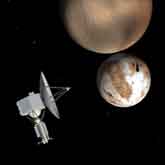Pluto: Beyond Neptune Or Not?
 Did I catch you? Pluto (newly classified as a dwarf-planet) comes after planet Neptune. Right? Depends. Pluto takes 248 years to orbit the Sun. Most of that time Pluto's orbit puts it outside the orbit of Neptune. But, for 20 years out of each orbit cycle, Pluto's orbit brings it closer to the Sun than Neptune. Most recently, Pluto was in 8th place from February, 1979 until February, 1999. Now, it's back beyond Neptune, and will stay there for the next 200 years.
Did I catch you? Pluto (newly classified as a dwarf-planet) comes after planet Neptune. Right? Depends. Pluto takes 248 years to orbit the Sun. Most of that time Pluto's orbit puts it outside the orbit of Neptune. But, for 20 years out of each orbit cycle, Pluto's orbit brings it closer to the Sun than Neptune. Most recently, Pluto was in 8th place from February, 1979 until February, 1999. Now, it's back beyond Neptune, and will stay there for the next 200 years.
Pluto is the only ex-planet (now a dwarf-planet) in our solar system to have this orbital characteristic. This is caused by its very elongated orbital path. Most planets travel around the Sun in an elliptical orbit that is closer in shape to a circle. They pretty much remain the same distance from the Sun during their annual trip. This is true of Neptune. But Pluto's orbital distance from the Sun varies by over 1.86 billion miles (about 3 billion km), enough to cause its orbital anomaly.
Don't worry about Pluto colliding with Neptune though. Pluto's different in that respect as well. Rather than orbiting on a relatively flat plane as the other planets do, Pluto's orbit brings it above and over the orbit of Neptune. Their paths don't cross.
About the Author
Gene Mascoli, JD
 Gene Mascoli is a founder and publisher of ScienceIQ.com. He holds a J.D. degree from the University of Santa Clara and a B.A. in English. In 1997 Gene launched ScienceMaster.com, an online science education portal where he brought together his love of writing with his interest in the sciences. Gene collaborated with David Gamon on the popular digital book
“The Internet Guide to NASA on the Net” and has also produced two popular science CD-ROMs on astronomy and space science.
Gene Mascoli is a founder and publisher of ScienceIQ.com. He holds a J.D. degree from the University of Santa Clara and a B.A. in English. In 1997 Gene launched ScienceMaster.com, an online science education portal where he brought together his love of writing with his interest in the sciences. Gene collaborated with David Gamon on the popular digital book
“The Internet Guide to NASA on the Net” and has also produced two popular science CD-ROMs on astronomy and space science.


